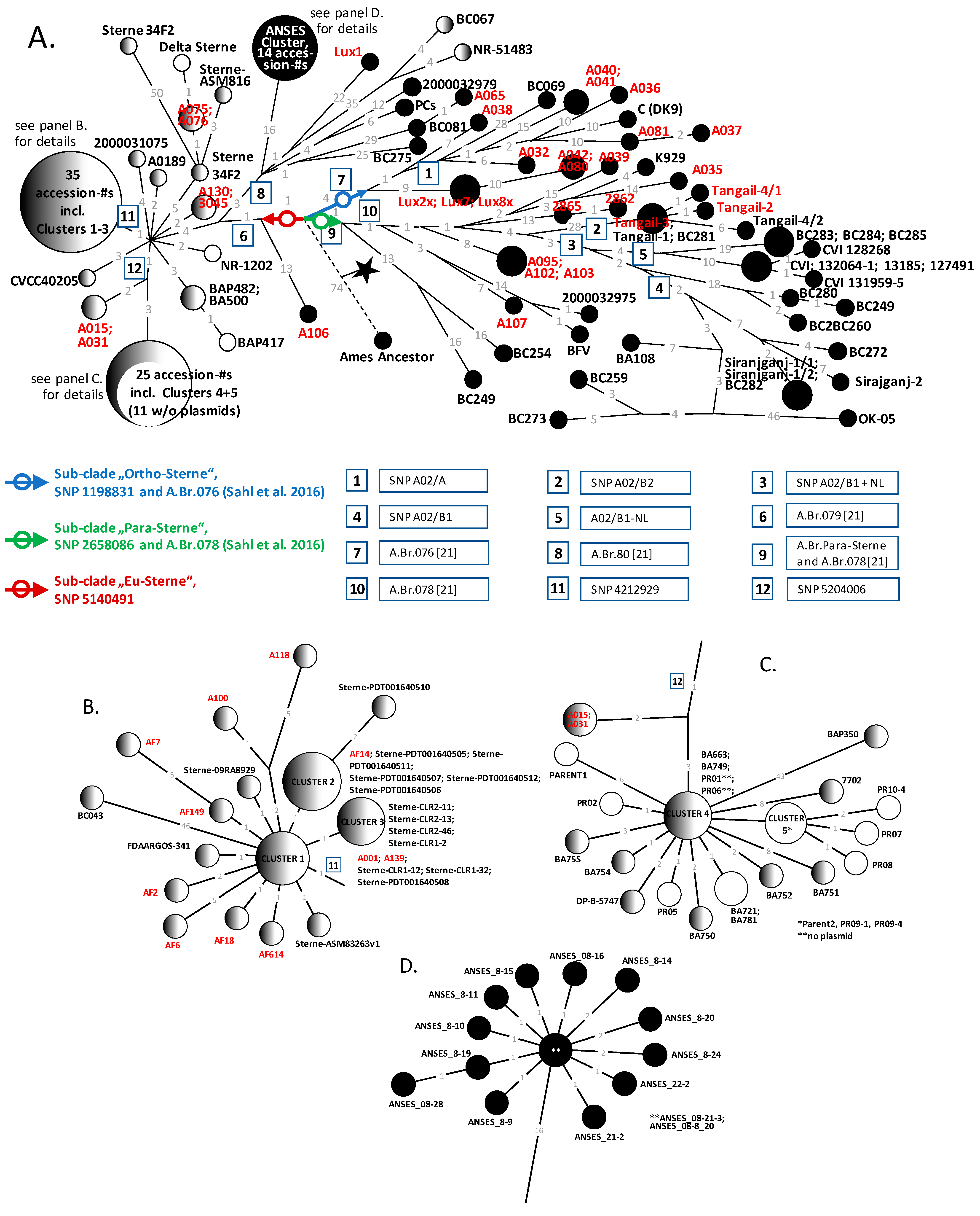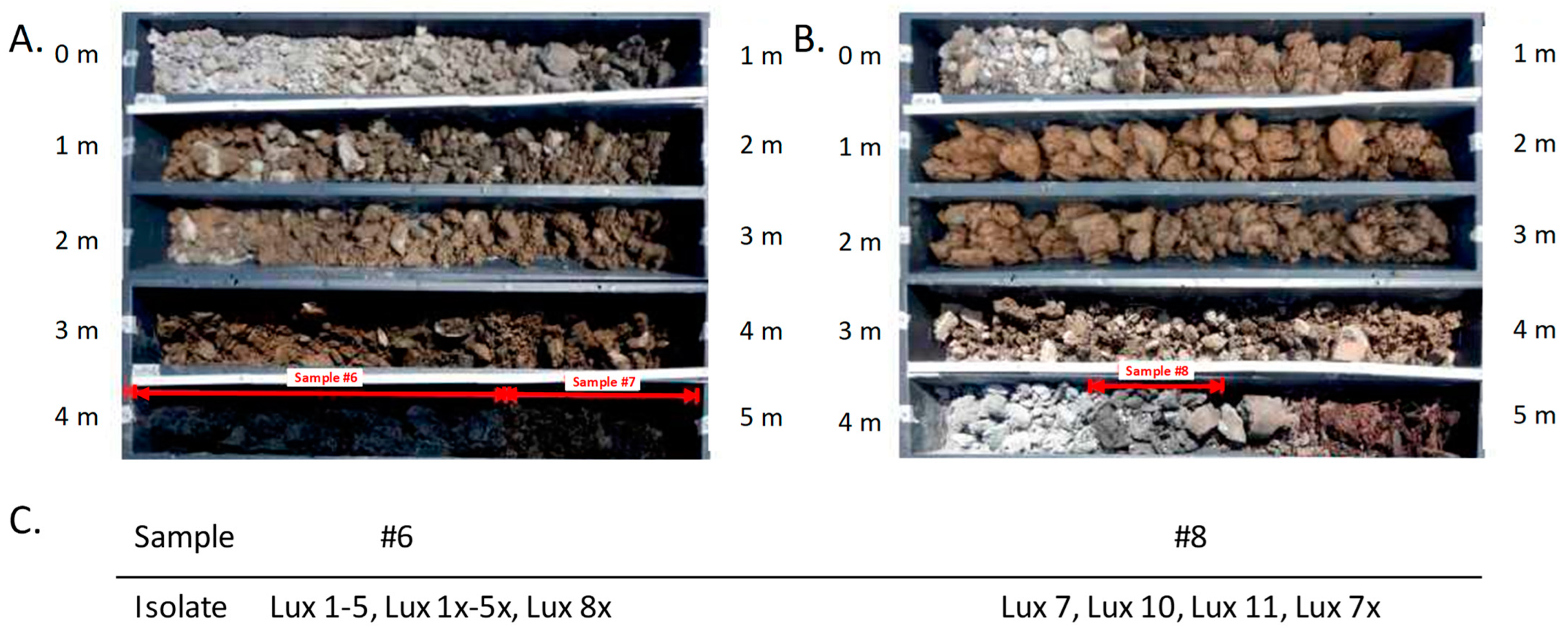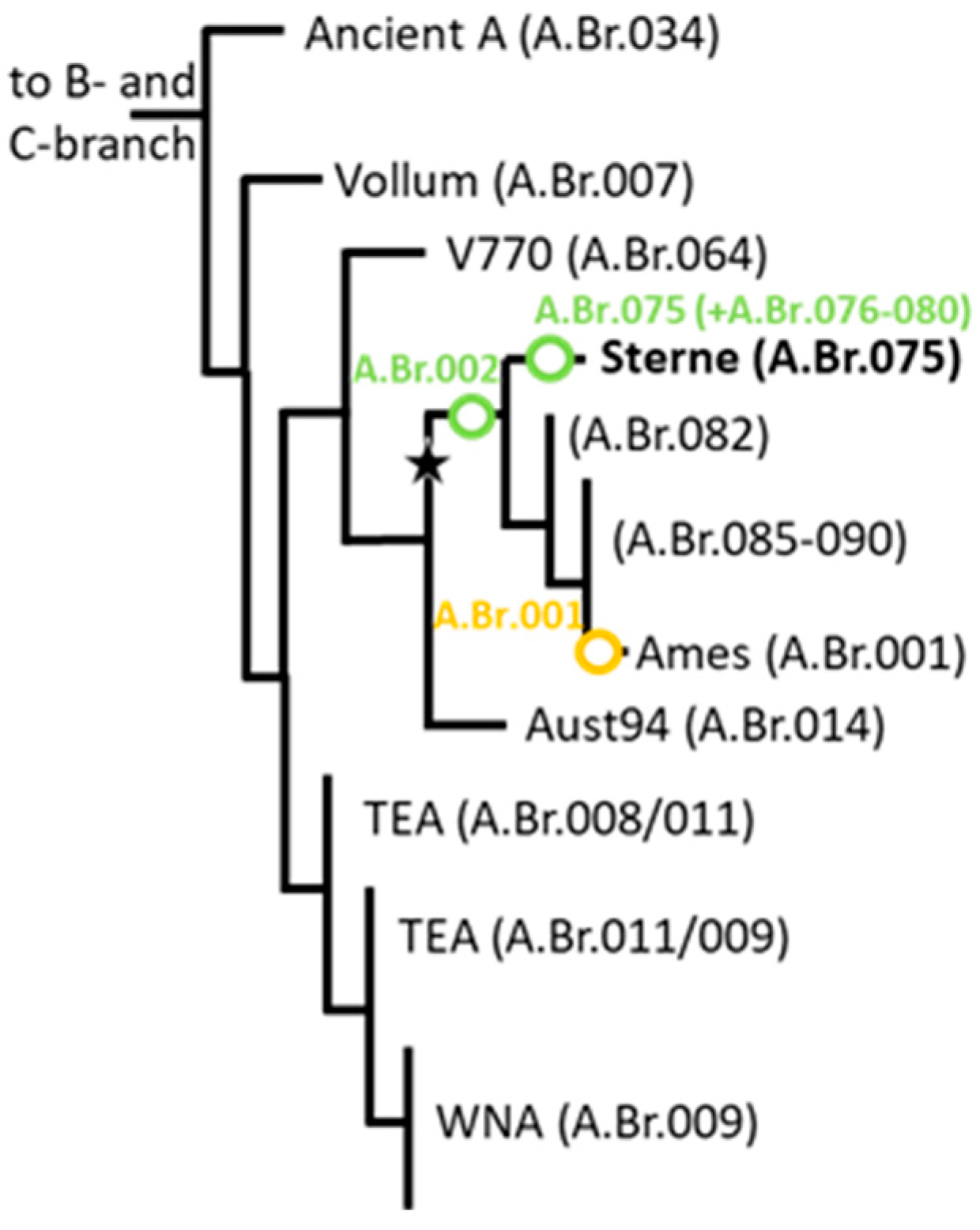Archival and Newly Isolated Historical Bacillus anthracis Strains Populate the Deeper Phylogeny of the A.Br.075(Sterne) Clade
Abstract
:1. Introduction
2. Materials and Methods
2.1. Collection of Soil Samples
2.2. Bacterial Culture, Inactivation, and Genomic DNA Preparation
2.3. Soil Sample Analysis by PCR and Culturing of B. anthracis
2.4. Enrichment of B. anthracis from PCR-Positive Soil Samples by Magnetic Separation and Culturing
2.5. Interrogation of SNPs via PCR by Relative Ct-Value Analysis (Delayed Mismatch Amplification PCR Assay, DMAA)
2.6. Whole Genome Sequencing
2.7. Analysis of Whole Genome Sequencing Data and SNP-Calling
3. Results
3.1. Live B. anthracis Could Be Isolated from Soil Samples of an Abandoned Tannery Site in Luxembourg
3.2. Preliminary Genotyping by DMAA canSNP-PCR Groups the New Soil Isolates to the A.Br.001/002 canSNP Clade
3.3. All Newly Sequenced Genomes Group Within the A.Br.075(Sterne) canSNP Clade Phylogeny
3.4. Three Distinct Lineages Within the A.Br.075(Sterne) canSNP Clade Include All Newly Sequenced Genomes

3.5. Most Newly Sequenced Isolates Including Three from Tannery Soil Populate Sub-Clade A.Br.Ortho-Sterne
3.6. Only One Sequenced Tannery Soil Isolate Group Within Sub-Clade A.Br.Eu-Sterne
3.7. The Majority of Strains from Sub-Clade A.Br.Eu-Sterne Are Lacking Virulence Plasmid pXO2
3.8. Most Newly Sequenced Archival Isolates of Sub-Clade A.Br.Para-Sterne Group Within Basal Lineages
3.9. Additional B. anthracis Strains of the A.Br.075 Clade Can Be Genotyped by New DMAA SNP-PCR Discriminatory Assays
4. Discussion
5. Conclusions
Supplementary Materials
Author Contributions
Funding
Institutional Review Board Statement
Informed Consent Statement
Data Availability Statement
Acknowledgments
Conflicts of Interest
References
- Ågren, J.; Finn, M.; Bengtsson, B.; Segerman, B. Microevolution during an Anthrax Outbreak Leading to Clonal Heterogeneity and Penicillin Resistance. PLoS ONE 2014, 9, e89112. [Google Scholar] [CrossRef] [PubMed]
- Braun, P.; Beyer, W.; Hanczaruk, M.; Riehm, J.M.; Antwerpen, M.; Otterbein, C.; Oesterheld, J.; Grass, G. Reoccurring Bovine Anthrax in Germany on the Same Pasture after 12 Years. J. Clin. Microbiol. 2022, 60, e0229121. [Google Scholar] [CrossRef] [PubMed]
- Turnbull, P.C. World Health Organization. Anthrax in Humans and Animals; WHO Press: Geneva, Switzerland, 2008. [Google Scholar]
- Hueffer, K.; Drown, D.; Romanovsky, V.; Hennessy, T. Factors Contributing to Anthrax Outbreaks in the Circumpolar North. Ecohealth 2020, 17, 174–180. [Google Scholar] [CrossRef]
- Timofeev, V.; Bahtejeva, I.; Mironova, R.; Titareva, G.; Lev, I.; Christiany, D.; Borzilov, A.; Bogun, A.; Vergnaud, G. Insights from Bacillus anthracis Strains Isolated from Permafrost in the Tundra Zone of Russia. PLoS ONE 2019, 14, e0209140. [Google Scholar] [CrossRef] [PubMed]
- Manchee, R.J.; Broster, M.G.; Melling, J.; Henstridge, R.M.; Stagg, A.J. Bacillus anthracis on Gruinard Island. Nature 1981, 294, 254–255. [Google Scholar] [CrossRef]
- Hugh-Jones, M.; Blackburn, J. The Ecology of Bacillus anthracis. Mol. Asp. Med. 2009, 30, 356–367. [Google Scholar] [CrossRef] [PubMed]
- Beyer, W.; Glockner, P.; Otto, J.; Bohm, R. A Nested PCR Method for the Detection of Bacillus anthracis in Environmental Samples Collected from Former Tannery Sites. Microbiol. Res. 1995, 150, 179–186. [Google Scholar] [CrossRef] [PubMed]
- Derzelle, S.; Aguilar-Bultet, L.; Frey, J. Comparative Genomics of Bacillus anthracis from the Wool Industry Highlights Polymorphisms of Lineage A.Br.Vollum. Infect. Genet. Evol. 2016, 46, 50–58. [Google Scholar] [CrossRef] [PubMed]
- Wattiau, P.; Klee, S.R.; Fretin, D.; Van Hessche, M.; Menart, M.; Franz, T.; Chasseur, C.; Butaye, P.; Imberechts, H. Occurrence and Genetic Diversity of Bacillus anthracis Strains Isolated in an Active Wool-Cleaning Factory. Appl. Env. Microbiol. 2008, 74, 4005–4011. [Google Scholar] [CrossRef] [PubMed]
- Hugh-Jones, M. 1996–97 Global Anthrax Report. J. Appl. Microbiol. 1999, 87, 189–191. [Google Scholar] [CrossRef] [PubMed]
- Schmid, G.; Kaufmann, A. Anthrax in Europe: Its Epidemiology, Clinical Characteristics, and Role in Bioterrorism. Clin. Microbiol. Infect. 2002, 8, 479–488. [Google Scholar] [CrossRef]
- Girault, G.; Blouin, Y.; Vergnaud, G.; Derzelle, S. High-Throughput Sequencing of Bacillus anthracis in France: Investigating Genome Diversity and Population Structure Using Whole-Genome SNP Discovery. BMC Genom. 2014, 15, 288. [Google Scholar] [CrossRef]
- Vergnaud, G.; Girault, G.; Thierry, S.; Pourcel, C.; Madani, N.; Blouin, Y. Comparison of French and Worldwide Bacillus anthracis Strains Favors a Recent, Post-Columbian Origin of the Predominant North-American Clade. PLoS ONE 2016, 11, e0146216. [Google Scholar] [CrossRef] [PubMed]
- Antwerpen, M.; Beyer, W.; Bassy, O.; Ortega-García, M.V.; Cabria-Ramos, J.C.; Grass, G.; Wölfel, R. Phylogenetic Placement of Isolates within the Trans-Eurasian Clade A.Br.008/009 of Bacillus anthracis. Microorganisms 2019, 7, 689. [Google Scholar] [CrossRef] [PubMed]
- Braun, P.; Knupfer, M.; Antwerpen, M.; Triebel, D.; Grass, G. A Rare Glimpse into the Past of the Anthrax Pathogen Bacillus anthracis. Microorganisms 2020, 8, 298. [Google Scholar] [CrossRef]
- Derzelle, S.; Girault, G.; Roest, H.I.; Koene, M. Molecular Diversity of Bacillus anthracis in the Netherlands: Investigating the Relationship to the Worldwide Population Using Whole-Genome SNP Discovery. Infect. Genet. Evol. 2015, 32, 370–376. [Google Scholar] [CrossRef] [PubMed]
- Sterne, M. Anthrax. In Infectious Diseases of Animals, Disease Due to Bacteria; Stableforth, A.W., Galloway, I.A., Eds.; Butterworth: London, UK, 1959; Volume 1, pp. 16–52. [Google Scholar]
- Beyer, W.; Bellan, S.; Eberle, G.; Ganz, H.H.; Getz, W.M.; Haumacher, R.; Hilss, K.A.; Kilian, W.; Lazak, J.; Turner, W.C.; et al. Distribution and Molecular Evolution of Bacillus anthracis Genotypes in Namibia. PLoS Negl. Trop. Dis. 2012, 6, e1534. [Google Scholar] [CrossRef]
- Lekota, K.E.; Hassim, A.; Ledwaba, M.B.; Glover, B.A.; Dekker, E.H.; Van Schalkwyk, L.O.; Rossouw, J.; Beyer, W.; Vergnaud, G.; Van Heerden, H. Bacillus anthracis in South Africa, 1975–2013: Are Some Lineages Vanishing? BMC Genom. 2024, 25, 742. [Google Scholar] [CrossRef] [PubMed]
- Sahl, J.W.; Pearson, T.; Okinaka, R.; Schupp, J.M.; Gillece, J.D.; Heaton, H.; Birdsell, D.; Hepp, C.; Fofanov, V.; Noseda, R.; et al. A Bacillus anthracis Genome Sequence from the Sverdlovsk 1979 Autopsy Specimens. MBio 2016, 7, e01501-16. [Google Scholar] [CrossRef]
- Van Ert, M.N.; Easterday, W.R.; Huynh, L.Y.; Okinaka, R.T.; Hugh-Jones, M.E.; Ravel, J.; Zanecki, S.R.; Pearson, T.; Simonson, T.S.; U’Ren, J.M.; et al. Global Genetic Population Structure of Bacillus anthracis. PLoS ONE 2007, 2, e461. [Google Scholar] [CrossRef] [PubMed]
- Derzelle, S.; Girault, G.; Kokotovic, B.; Angen, O. Whole Genome-Sequencing and Phylogenetic Analysis of a Historical Collection of Bacillus anthracis Strains from Danish Cattle. PLoS ONE 2015, 10, e0134699. [Google Scholar] [CrossRef] [PubMed]
- Okutani, A.; Inoue, S.; Morikawa, S. Comparative Genomics and Phylogenetic Analysis of Bacillus anthracis Strains Isolated from Domestic Animals in Japan. Infect. Genet. Evol. 2019, 71, 128–139. [Google Scholar] [CrossRef]
- Rume, F.I.; Ahsan, C.R.; Biswas, P.K.; Yasmin, M.; Braun, P.; Walter, M.C.; Antwerpen, M.; Grass, G.; Hanczaruk, M. Unexpected Genomic Relationships between Bacillus anthracis Strains from Bangladesh and Central Europe. Infect. Genet. Evol. 2016, 45, 66–74. [Google Scholar] [CrossRef] [PubMed]
- Lekota, K.E.; Hassim, A.; Madoroba, E.; Hefer, C.A.; Van Heerden, H. Phylogenomic Structure of Bacillus anthracis Isolates in the Northern Cape Province, South Africa Revealed Novel Single Nucleotide Polymorphisms. Infect. Genet. Evol. 2020, 80, 104146. [Google Scholar] [CrossRef]
- Fasanella, A.; Di Taranto, P.; Garofolo, G.; Colao, V.; Marino, L.; Buonavoglia, D.; Pedarra, C.; Adone, R.; Hugh-Jones, M. Ground Anthrax Bacillus Refined Isolation (GABRI) Method for Analyzing Environmental Samples with Low Levels of Bacillus anthracis Contamination. BMC Microbiol. 2013, 13, 167. [Google Scholar] [CrossRef] [PubMed]
- Braun, P.; Wolfschläger, I.; Reetz, L.; Bachstein, L.; Jacinto, A.C.; Tocantins, C.; Poppe, J.; Grass, G. Rapid Microscopic Detection of Bacillus anthracis by Fluorescent Receptor Binding Proteins of Bacteriophages. Microorganisms 2020, 8, 934. [Google Scholar] [CrossRef]
- Antwerpen, M.H.; Zimmermann, P.; Bewley, K.; Frangoulidis, D.; Meyer, H. Real-Time PCR System Targeting a Chromosomal Marker Specific for Bacillus anthracis. Mol. Cell Probes 2008, 22, 313–315. [Google Scholar] [CrossRef]
- Birdsell, D.N.; Pearson, T.; Price, E.P.; Hornstra, H.M.; Nera, R.D.; Stone, N.; Gruendike, J.; Kaufman, E.L.; Pettus, A.H.; Hurbon, A.N.; et al. Melt Analysis of Mismatch Amplification Mutation Assays (Melt-MAMA): A Functional Study of a Cost-Effective SNP Genotyping Assay in Bacterial Models. PLoS ONE 2012, 7, e32866. [Google Scholar] [CrossRef]
- Antwerpen, M.; Beyer, W.; Grass, G. New Insights into the Phylogeny of the A.Br.161 (“A.Br.Heroin”) Clade of Bacillus anthracis. Pathogens 2024, 13, 593. [Google Scholar] [CrossRef] [PubMed]
- Braun, P.; Grass, G.; Aceti, A.; Serrecchia, L.; Affuso, A.; Marino, L.; Grimaldi, S.; Pagano, S.; Hanczaruk, M.; Georgi, E.; et al. Microevolution of Anthrax from a Young Ancestor (M.A.Y.A.) Suggests a Soil-Borne Life Cycle of Bacillus anthracis. PLoS ONE 2015, 10, e0135346. [Google Scholar] [CrossRef]
- Bankevich, A.; Nurk, S.; Antipov, D.; Gurevich, A.A.; Dvorkin, M.; Kulikov, A.S.; Lesin, V.M.; Nikolenko, S.I.; Pham, S.; Prjibelski, A.D.; et al. SPAdes: A New Genome Assembly Algorithm and Its Applications to Single-Cell Sequencing. J. Comput. Biol. 2012, 19, 455–477. [Google Scholar] [CrossRef]
- Walker, B.J.; Abeel, T.; Shea, T.; Priest, M.; Abouelliel, A.; Sakthikumar, S.; Cuomo, C.A.; Zeng, Q.; Wortman, J.; Young, S.K.; et al. Pilon: An Integrated Tool for Comprehensive Microbial Variant Detection and Genome Assembly Improvement. PLoS ONE 2014, 9, e112963. [Google Scholar] [CrossRef]
- Treangen, T.J.; Ondov, B.D.; Koren, S.; Phillippy, A.M. The Harvest Suite for Rapid Core-Genome Alignment and Visualization of Thousands of Intraspecific Microbial Genomes. Genome Biol. 2014, 15, 524. [Google Scholar] [CrossRef] [PubMed]
- Nixon, K.C. The Parsimony Ratchet, a New Method for Rapid Parsimony Analysis. Cladistics Int. J. Willi Hennig Soc. 1999, 15, 407–414. [Google Scholar] [CrossRef]
- Schliep, K.P. Phangorn: Phylogenetic Analysis in R. Bioinformatics 2011, 27, 592–593. [Google Scholar] [CrossRef]
- Zhou, Z.; Alikhan, N.-F.; Sergeant, M.J.; Luhmann, N.; Vaz, C.; Francisco, A.P.; Carriço, J.A.; Achtman, M. GrapeTree: Visualization of Core Genomic Relationships among 100,000 Bacterial Pathogens. Genome Res. 2018, 28, 1395–1404. [Google Scholar] [CrossRef] [PubMed]
- Simonson, T.S.; Okinaka, R.T.; Wang, B.; Easterday, W.R.; Huynh, L.; U’Ren, J.M.; Dukerich, M.; Zanecki, S.R.; Kenefic, L.J.; Beaudry, J.; et al. Bacillus anthracis in China and Its Relationship to Worldwide Lineages. BMC Microbiol. 2009, 9, 71. [Google Scholar] [CrossRef]
- Metrailer, M.C.; Hoang, T.T.H.; Jiranantasak, T.; Luong, T.; Hoa, L.M.; Ngoc, D.B.; Pham, Q.T.; Pham, V.K.; Hung, T.T.M.; Huong, V.T.L.; et al. Spatial and Phylogenetic Patterns Reveal Hidden Infection Sources of Bacillus anthracis in an Anthrax Outbreak in Son La Province, Vietnam. Infect. Genet. Evol. 2023, 114, 105496. [Google Scholar] [CrossRef] [PubMed]
- Kenefic, L.J.; Pearson, T.; Okinaka, R.T.; Chung, W.K.; Max, T.; Trim, C.P.; Beaudry, J.A.; Schupp, J.M.; Van Ert, M.N.; Marston, C.K.; et al. Texas Isolates Closely Related to Bacillus anthracis Ames. Emerg. Infect. Dis. 2008, 14, 1494–1496. [Google Scholar] [CrossRef]
- Derzelle, S.; Thierry, S. Genetic Diversity of Bacillus anthracis in Europe: Genotyping Methods in Forensic and Epidemiologic Investigations. Biosecur. Bioterror. 2013, 11 (Suppl. 1), S166–S176. [Google Scholar] [CrossRef] [PubMed]
- Eremenko, E.; Pechkovskii, G.; Pisarenko, S.; Ryazanova, A.; Kovalev, D.; Semenova, O.; Aksenova, L.; Timchenko, L.; Golovinskaya, T.; Bobrisheva, O.; et al. Phylogenetics of Bacillus anthracis Isolates from Russia and Bordering Countries. Infect. Genet. Evol. 2021, 92, 104890. [Google Scholar] [CrossRef] [PubMed]
- Wang, D.; Wang, B.; Zhu, L.; Wu, S.; Lyu, Y.; Feng, E.; Pan, C.; Jiao, L.; Cui, Y.; Liu, X.; et al. Genotyping and Population Diversity of Bacillus anthracis in China Based on MLVA and canSNP Analysis. Microbiol. Res. 2020, 233, 126414. [Google Scholar] [CrossRef]
- Zhang, H.; Zhang, E.; He, J.; Li, W.; Wei, J. Genetic Characteristics of Bacillus anthracis Isolated from Northwestern China from 1990 to 2016. PLoS Negl. Trop. Dis. 2018, 12, e0006908. [Google Scholar] [CrossRef] [PubMed]
- Timofeev, V.; Bakhteeva, I.; Khlopova, K.; Mironova, R.; Titareva, G.; Goncharova, Y.; Solomentsev, V.; Kravchenko, T.; Dyatlov, I.; Vergnaud, G. New Research on the Bacillus anthracis Genetic Diversity in Siberia. Pathogens 2023, 12, 1257. [Google Scholar] [CrossRef]
- Pilo, P.; Frey, J. Bacillus anthracis: Molecular Taxonomy, Population Genetics, Phylogeny and Patho-Evolution. Infect. Genet. Evol. 2011, 11, 1218–1224. [Google Scholar] [CrossRef]
- Pilo, P.; Perreten, V.; Frey, J. Molecular Epidemiology of Bacillus anthracis: Determining the Correct Origin. Appl. Environ. Microbiol. 2008, 74, 2928–2931. [Google Scholar] [CrossRef] [PubMed]
- Finke, E.J.; Beyer, W.; Loderstädt, U.; Frickmann, H. Review: The Risk of Contracting Anthrax from Spore-Contaminated Soil—A Military Medical Perspective. Eur. J. Microbiol. Immunol. Bp. 2020, 10, 29–63. [Google Scholar] [CrossRef]
- Wilson, J.B.; Russell, K.E. Isolation of Bacillus anthracis from Soil Stored 60 Years. J. Bacteriol. 1964, 87, 237–238. [Google Scholar] [CrossRef] [PubMed]
- Wu, Y.; Yuan, Y.; Yuan, B.; Li, J.; Wang, J.; Cui, Y. Bacteriologic and Genomic Investigation of Bacillus anthracis Isolated from World War II Site, China. Emerg. Infect. Dis. 2024, 30, 2687–2689. [Google Scholar] [CrossRef] [PubMed]
- De Vos, V. The Ecology of Anthrax in the Kruger National Park, South Africa. Salisb. Med. Bull. 1990, 68S, 19–23. [Google Scholar]
- Liskova, E.A.; Egorova, I.Y.; Selyaninov, Y.O.; Razheva, I.V.; Gladkova, N.A.; Toropova, N.N.; Zakharova, O.I.; Burova, O.A.; Surkova, G.V.; Malkhazova, S.M.; et al. Reindeer Anthrax in the Russian Arctic, 2016: Climatic Determinants of the Outbreak and Vaccination Effectiveness. Front. Vet. Sci. 2021, 8, 668420. [Google Scholar] [CrossRef] [PubMed]
- Cooper, C.; Buyuk, F.; Schelkle, B.; Saglam, A.G.; Celik, E.; Celebi, O.; Sahin, M.; Hawkyard, T.; Baillie, L. Virulence Plasmid Stability in Environmentally Occurring Bacillus anthracis from North East Turkey. Antonie Van Leeuwenhoek 2016, 110, 167–170. [Google Scholar] [CrossRef] [PubMed]
- Turnbull, P.C.B.; Hutson, R.A.; Ward, M.J.; Jones, M.N.; Quinn, C.P.; Finnie, N.J.; Duggleby, C.J.; Kramer, J.M.; Melling, J. Bacillus anthracis but Not Always Anthrax. J. Appl. Bacteriol. 1992, 72, 21–28. [Google Scholar] [CrossRef] [PubMed]
- Bishop, A.H. Germination and Persistence of Bacillus anthracis and Bacillus thuringiensis in Soil Microcosms. J. Appl. Microbiol. 2014, 117, 1274–1282. [Google Scholar] [CrossRef] [PubMed]
- Van Ness, G.B. Ecology of Anthrax. Science 1971, 172, 1303–1307. [Google Scholar] [CrossRef]
- Hsieh, H.-Y.; Stewart, G.C. Does Environmental Replication Contribute to Bacillus anthracis Spore Persistence and Infectivity in Soil? Res. Microbiol. 2023, 174, 104052. [Google Scholar] [CrossRef]


| DMAA-Test 1 | Strain | Δ(CtDER–CtANC) 2 | SNP-Allele | canSNP Group |
|---|---|---|---|---|
| canSNP A.Br.001 (A.Br.Ames) | Lux1-5, Lux7, Lux10, Lux11, Lux1x-5x, Lux7x, Lux8x | 19.2 ± 0.5 | ANC | Non-A.Br.001 |
| A.Br.001 strains | −13.4 ± 4.0 | DER | A.Br.001 | |
| A.Br.002 strains | 17.2 ± 2.5 | ANC | Non-A.Br.001 | |
| canSNP A.Br.002 (A.Br.Sterne) | Lux1-5, Lux7, Lux10, Lux11, Lux1x-5x, Lux7x, Lux8x | −10.3 ± 0.7 | DER | A.Br.002 |
| A.Br.002 strains | −10.2 ± 0.8 | DER | A.Br.002 | |
| Other A.Br. strains * | 9.9 ± 0.4 | ANC | Non-A.Br.002 |
| DMAA-Test * | Strain Name | Δ(CtDER –CtANC) ** | SNP Allele | (can)SNP Group |
|---|---|---|---|---|
| Sub-clade ‘Ortho-Sterne’ 1 (position identical to A.Br.076 ***) | Lux2-5, Lux7, Lux10, Lux11, Lux1x-5x, Lux7x, Lux8x, A034, A037, A040, A066 | −13.2 ± 2.4 | DER | ‘Ortho-Sterne’ |
| Lux1, Ames, Sterne(A118), A014, A031, A103, A151, A153, A154, A210 | 14.7 ± 2.2 | ANC | Non-‘Ortho-Sterne’ | |
| Sub-clade ‘Para-Sterne’ 2 (position identical to A.Br.078 ***) | A095, A102, A107, A81, CVI 131959, Sirajganj-2, A103 | −11.3 ± 2.1 | DER | ‘Para-Sterne’ |
| Lux1-5, Lux7, Lux10, Lux11, Lux1x-5x, Lux7x, Lux8x, Sterne(A118), A100, A106, A014, A031, A151, A153, A154, A210 | 11.3 ± 1.9 | ANC | Non-‘Para-Sterne’ | |
| Sub-clade ‘Eu-Sterne’ 3 | Lux1, Sterne(A118), A31, A100, A106, A123, A065, A178 | −6.5 ± 1.9 | DER | ‘Eu- Sterne’ |
| Lux2-5, Lux7, Lux10, Lux11, Lux1x-5x, Lux7x, Lux8x, A014, A015, A103, A106, A151, A153, A154, A210, 2862, Sirajganj-2 | 12.5 ± 2.2 | ANC | Non-‘Eu-Sterne’ | |
| Sub-clade A.Br.079 ***4 | Lux1, A015, A100 | −13.7 ± 3.2 | DER | A.Br.079 |
| Lux2x, A106, Sirajganj-2 | 11.6 ± 2.9 | ANC | Non-A.Br.079 | |
| Sub-clade A.Br.080 ***5 | Lux1, A065 | −11.3 ± 0.6 | DER | A.Br.080 |
| Lux2x, Sterne(A118) | 10.8 ± 0.9 | ANC | Non-A.Br.080 | |
| Sub-clade A02/B1+NL ****6 | Sirajganj-2, CVI 13185 | −8.8 ± 2.1 | DER | A02/B1+NL |
| Sterne(A118), 2865, Tangail-3 | 9.8 ± 0.7 | ANC | Non- A02/B1+NL | |
| Sub-clade SNP 4212929 7 | A100, A118, AF7, AF18 | −11.6 ± 0.3 | DER | 4212929 |
| A015, A031 | 13.6 ± 5.0 | ANC | Non- 4212929 | |
| Sub-clade SNP 5204006 8 | A015, A031 | −8.5 ± 0.8 | DER | 5204006 |
| A100, AF7 | 8.6 ± 0.3 | ANC | Non- 5204006 |
Disclaimer/Publisher’s Note: The statements, opinions and data contained in all publications are solely those of the individual author(s) and contributor(s) and not of MDPI and/or the editor(s). MDPI and/or the editor(s) disclaim responsibility for any injury to people or property resulting from any ideas, methods, instructions or products referred to in the content. |
© 2025 by the authors. Licensee MDPI, Basel, Switzerland. This article is an open access article distributed under the terms and conditions of the Creative Commons Attribution (CC BY) license (https://creativecommons.org/licenses/by/4.0/).
Share and Cite
Antwerpen, M.; Braun, P.; Beyer, W.; Aldenkortt, D.; Seidel, M.; Grass, G. Archival and Newly Isolated Historical Bacillus anthracis Strains Populate the Deeper Phylogeny of the A.Br.075(Sterne) Clade. Pathogens 2025, 14, 83. https://doi.org/10.3390/pathogens14010083
Antwerpen M, Braun P, Beyer W, Aldenkortt D, Seidel M, Grass G. Archival and Newly Isolated Historical Bacillus anthracis Strains Populate the Deeper Phylogeny of the A.Br.075(Sterne) Clade. Pathogens. 2025; 14(1):83. https://doi.org/10.3390/pathogens14010083
Chicago/Turabian StyleAntwerpen, Markus, Peter Braun, Wolfgang Beyer, Dirk Aldenkortt, Michael Seidel, and Gregor Grass. 2025. "Archival and Newly Isolated Historical Bacillus anthracis Strains Populate the Deeper Phylogeny of the A.Br.075(Sterne) Clade" Pathogens 14, no. 1: 83. https://doi.org/10.3390/pathogens14010083
APA StyleAntwerpen, M., Braun, P., Beyer, W., Aldenkortt, D., Seidel, M., & Grass, G. (2025). Archival and Newly Isolated Historical Bacillus anthracis Strains Populate the Deeper Phylogeny of the A.Br.075(Sterne) Clade. Pathogens, 14(1), 83. https://doi.org/10.3390/pathogens14010083







